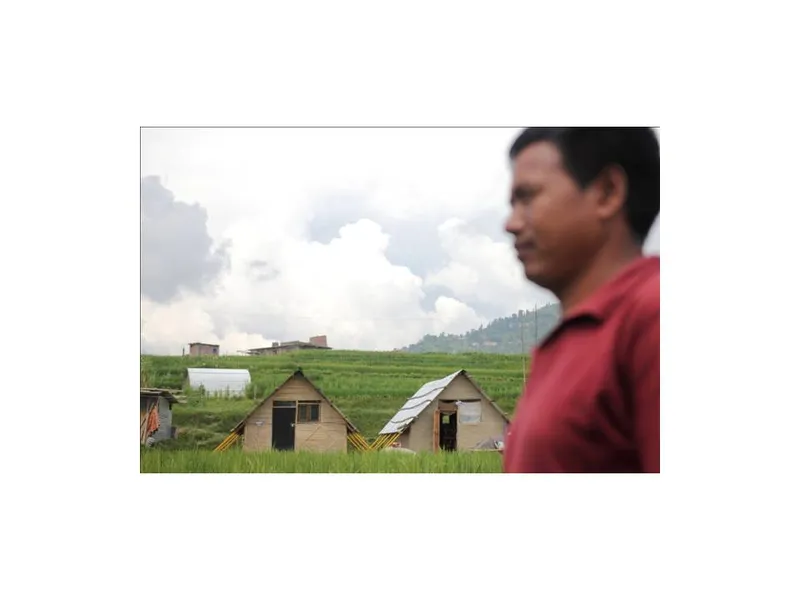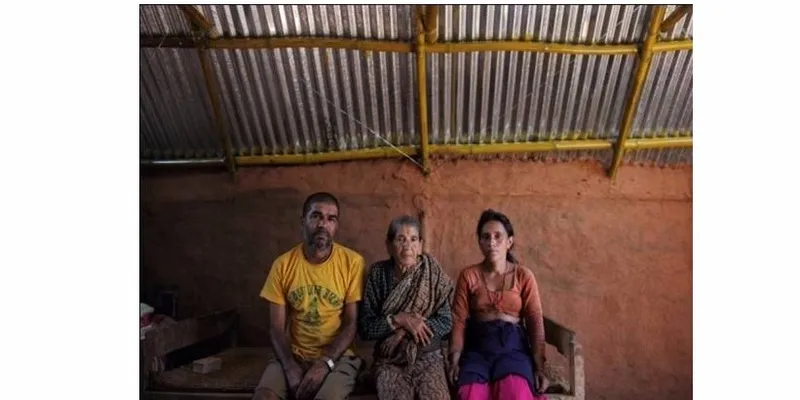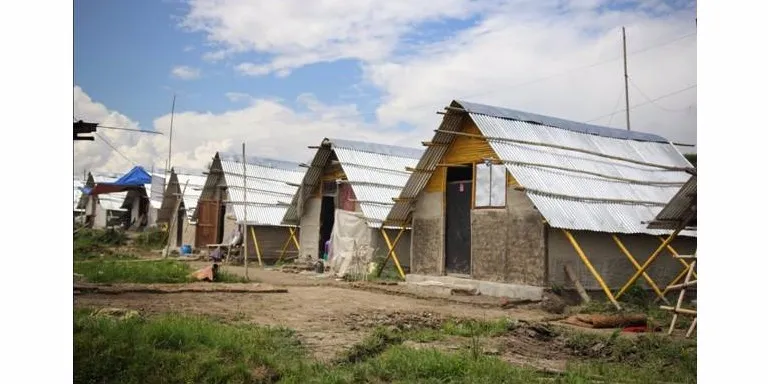

In a gap of less than 15 days, Nepal was hit by two high intensity earthquakes early this year. It left behind a trail of sorrow and enormous destruction. According to Nepal Disaster Recovery and Reconstruction Information Platform, the earthquake claimed 8856 lives while leaving 6, 02,257 houses extensively damaged.
With houses either collapsed or severely damaged, numerous families were forced to stay outdoors with no roof over their heads. Fast approaching monsoons called for immediate intervention in terms of reconstruction or restoration of houses. Meanwhile over 6 lakh families needed a roof and a safe abode until a permanent house is constructed.
SEEDS, with its experience of working post disasters in providing interim shelter, soon set on the task of designing earthquake resilient and terrain specific transitional shelters for families in Nepal. The arrangement required was such that maximum families should have shelters in minimum possible time and therefore, a community driven approach was vital.
With the goal of reaching out to 2200 families, SEEDS with support from its Indian donors and Choudhary group, one of the biggest corporate houses in Nepal, soon began the on ground construction of shelters by mid June 2015. This multiple partnership and community driven approach soon gained momentum such that time taken for construction of one shelter took less than 3 days. As on 28th October 2015, SEEDS has completed construction of 1165 such shelters and the work continues despite of fuel crises and political unrest in the country.
Dr. Manu Gupta, Executive Director, SEEDS states, “Construction of permanent houses was delayed as government guidelines for new construction and compensation packages would take significant time to materialize….It was a herculean task at hand, with fast approaching monsoons. A transition from Relief to Recovery was inevitable. Something was required to be done immediately. All thanks to our supporters, partners like Choudhary Foundation, PricewaterhouseCoopers C and the commendable spirit of people of Nepal, we were able to finish the first 1000 in less than 100 days.
Situation in Nepal remained precarious with continuing tremors and aftershocks in early days after the earthquake. Families could not have survived in tents and tarpaulin sheets alone for such long periods. Also, many families were afraid to return to their damaged homes, and therefore transitional shelter was the most viable option till a permanent house could be reconstructed.
SEEDS has supported 2520 families across 11 districts of Nepal with transitional shelters, thus providing safe abode to families in Nepal for next 3-5 years until they are able to construct a permanent house as per government guidelines and compensation packages they receive from the government.
Transitional Homes
Unlike a temporary shelter, transitional homes or shelters are earthquake resilient and more durable in nature. The transitional homes constructed by SEEDS are designed to take minimum time for construction, using locally available materials and are earthquake resilient.
Yet another unique aspect of the intervention is the extensive beneficiary participation. At least one member of each family was oriented and given basic training on construction of the shelters. Thus, as the participation increased, so did the ownership towards the intervention by the families. In this case, the house owner was responsible for excavation, construction of plinth, and undertaking the wall plastering for the house. Materials for construction were provided to the families. SEEDS’ supervisors and mobilisers at site provided necessary assistance and aid to these families for construction of their houses.
Building with partnership
On board with SEEDS, for carrying out the intervention was Choudhary Foundation, the CSR wing of Choudhary Group of Nepal, who provided assistance by funding for the construction of shelters, support in getting permissions, beneficiary identification, material and logistic support. Also on board was PricewaterhouseCoopers (PWC) for the support in monitoring and evaluation functions.
About Transitional Homes
Unlike a temporary shelter, transitional homes or shelters are more earthquake resilient and durable in nature.The transitional homes constructed by SEEDS are designed to take minimum time for construction, using locally available materials and are earthquake resilient. The salient features of the transitional shelters are as follows:
- Quick construction within 3 days
- Low cost technology of just 750 USD per shelter
- Locally available material like bamboo, stones, brick and CGI roofing sheets
- Doable using local construction skills
- Acceptable and adaptable for local community
- Size of the shelter is 17.8 m2 meeting the Sphere minimum standards of 3.5 m2 per person, with average family size of 5 members.
- Structural design considering earthquake risks and strong winds
- Reusability of materials for future permanent construction
Changing lives
An invincible spirit
“I didn’t know if I would survive. Here I am no longer scared of the earthquake. For me, this house is even better than a palace” says Harimai Rijal, Ward 5, Kharanitar VDC, Nuakot
90-year-old Harimai Rijal displays a strength and spirit of invincibility that is inspiring. She lives with her brother and sister-in-law. When the earth shook, the two women were at home. Her sister-in –law was able to evacuate. Harimai just managed to crawl under the bed before the four- story house collapsed around her. Luckily, her family began to search for her immediately, but the debris was so dense that it took them over an hour to get her out. At that time, I never thought that I’d be in a house like this, she recalls. “A nice place where I can peacefully spend the rest of my years. In fact, I did some of the plastering with my own hands.”
For her family too, the house signifies both safety as well as a new start. “Here it much cooler,” Sahadev Upreti comments, “in many ways nicer even than our old house.”
A shared empathy
“My house got made, but others also need to construct. Whatever my pain, others feel the same pain. So I decided to become a trainer. The people standing in front of me expect things from me – my techniques. I feel happy to give them an idea of how to make the house, to follow the design so we will stay safe. This house is strong so you must make it, I tell them. At that time people really pay attention and I feel good that whatever I am doing is heartfelt.” – Bishnu, Changunaryan, Bhaktapur District.
For Bishnu’s family, the earthquake claimed almost everything they owned and their new house is stacked with whatever they could salvage. The trainer job has been a way to also earn some money. So far, aside from his own village, Bishnu has overseen the construction of houses in Dholalghat and Ramechap. Sometimes he has to work really hard to motivate and convince people. Yet, the experience has made him want to keep contributing. “Wherever problems occur, I want to go there and help,” he says. “National or international, wherever there’s an earthquake or other problems, I’ll want to offer assistance. If I get the opportunity I will definitely go.”

Transitional homes for Nepal Earthquake victims

A family living in transitional home

Transitional Homes




1564577705723.jpg?mode=crop&crop=faces&ar=16%3A9&format=auto&w=1920&q=75)

